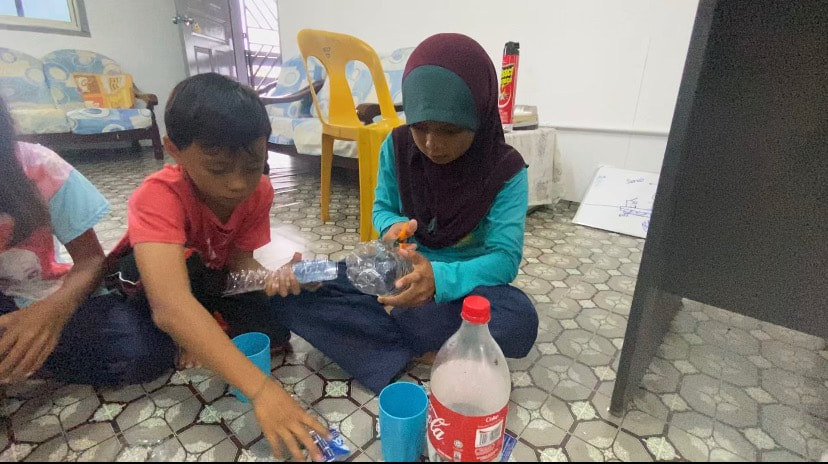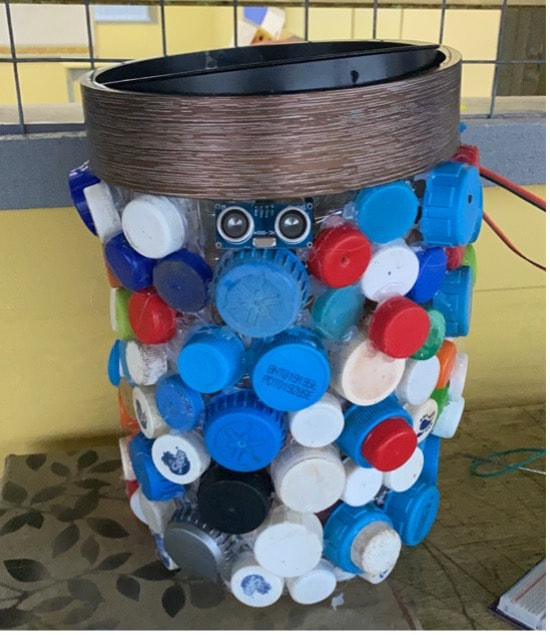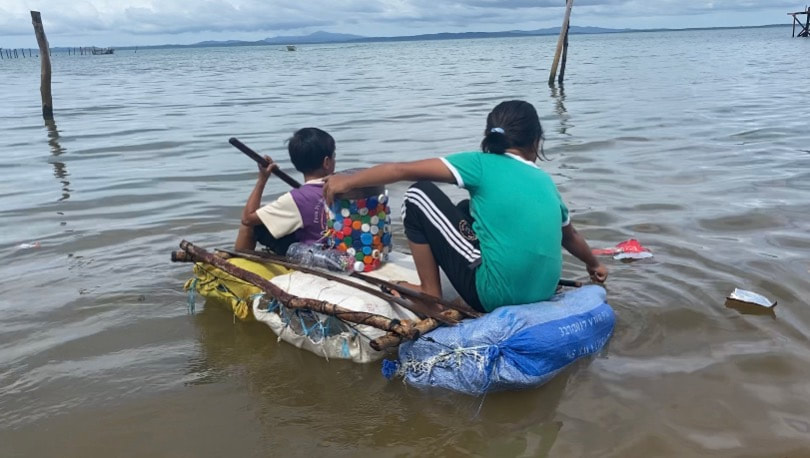|
by Michelle Petrus Overview I always believe that younger generation is the key to a better future. I was fortunate to be introduced to the technology of Arduino and coding from Chumbaka to encourage young pupils, especially in low-resource primary schools, to use technology and to innovate. This article will describe the learning journey of a group of children on a remote island in Kudat, Sabah: from knowing nothing about electronic components to developing an innovation that they called the ‘Smart Bin.’ This learning journey had not only opened up a new world of learning opportunities for the pupils; it had also given them the chance to serve their community by solving the lingering problems of trash around the island. A New Life on the Island I started my teaching journey on the beautiful island of Pulau Banggi, at SK Tanjung Manawali in June 2019 after moving from SK Pendidikan Khas Kota Kinabalu, Tuaran. Teaching in a rural school with limited resources and access to facilities after a couple of years serving in a relatively well-resourced suburban school has been a major shift of experience. To reach the school from Sabah’s capital city of Kota Kinabalu, one has to travel for 180 kilometres by road to Kudat town, and then journey on for another 53 kilometres by boat from Kudat to Banggi Island. Due to its remote location, pupils have very limited access to learning resources, media and exposures to the ‘outside world.’ Poverty has also limited the children’s access to things that we normally take for granted. For example, instead of playing with commercial toys like dolls, building blocks, toy cars and others that we can normally get very easily from the store, the kids collected whatever debris that the sea current brings to the shore and made toys out of them. Defining ‘play’ in the way that most city kids would, such as playing online and virtual games or getting endless entertainments from their mobile phones is a totally alien concept for these island kids. I am always amazed by the kids’ creativity in creating toys out of stuffs that we would normally discard without a second thought. As the saying goes, “one man’s trash is another man’s treasure.” Exploring Possibilities So when I stumbled upon Chumbaka, a program that introduces children to coding and innovations, I was immediately inspired. I knew that this was something that I definitely should introduce to my pupils. It reminded me of the kids’ ingenuity and resourcefulness in creating toys out of trash, and I was excited to see what could be made possible if the pupils were given the chance to combine their raw and natural talent in creating and innovating with the potentials that technology can offer. I started by exposing the technology of Arduino to my pupils. It piqued their curiosities and encouraged them to learn more about innovations and how to innovate. My kids were ambitious. They wanted to create something that could make life better for the island community. One of the most pressing issues in this island is the problem with trash. The trash did not originate 100% from the island itself; some, if not most, were brought to the shores by the sea current from places like the mainland, from neighbouring islands, and elsewhere. During one of our brainstorming sessions, we talked about the possibilities of coming up with an innovation to solve this problem. After a few rounds of discussions, the kids decided to create a robot that can be used to pick up trash around the island. They wanted to call it the ‘Smart Bin.’ A truly novel idea. Amidst all the excitements of creating our very first robot, we suddenly realised something: we did not have the appropriate materials to create the Smart Bin. We did not even have a bin to start with! I could sense the disappointment in the pupils’ faces for a brief second. But it was merely for a brief second. Having identified the major hurdle, the kids continued to sit in a circle discussing, brainstorming, exploring possibilities. I remember very well how it looked and felt like; it was a serious brainstorming session. Suddenly the kids were no longer kids, they looked a lot like adults having a meeting on how to fly a rocket to Mars. I had never seen my pupils being that engrossed, it gave me goosebumps! And the result was something brilliant, something that went beyond my expectations. Poverty has also limited the children’s access to things that we normally take for granted. For example, instead of playing with commercial toys like dolls, building blocks, toy cars and others that we can normally get very easily from the store, the kids collected whatever debris that the sea current brings to the shore and made toys out of them. Moving Up A Notch The pupils decided to create the Smart Bin using recycled materials, from trash that they collected from the beach. From there, the project had just moved up a notch. The pupils were literally using trash to solve the problems of trash. Nothing could have been more brilliant than that! Every day, I would spend some time to teach the kids everything they need to know about wiring, electrical components, and coding so that they could start building the operating system. Resources were still a major hindrance, since not everything can be solved with recycled materials. One example is AA batteries. To get the system running, we need at least four brand new AA batteries. These were not something that you could simply pick up from the beach. To solve this problem, we sought the help of my colleague, who is also a teacher in my school. He had to travel by boat to the nearby Banggi Island (which took about 40 minutes) to buy some AA batteries for us. It was quite a hassle, but we knew that the outcome would be worth it. After a few hours of coding and tinkering, the system was finally ready. The next step was to go to the beach to collect empty bottles and other materials and to start building the prototype. It was not all smooth sailing, of course. I tried to ensure the pupils’ safety as best I could, and the kids themselves were very careful at all times. But accidents did happen. A few pupils hurt themselves while cutting the bottles into pieces, and a few others got burns while operating the hot glue gun. But their relentless spirits were admirable. Instead of lamenting about their unfortunate experiences, they simply brushed it off and said: “It’s okay, teacher. It’s just a small wound. We can still continue the work.” I realised there and then how much the pupils wanted this project to be successful – for their Smart Bin to become a reality. As a teacher, I was deeply moved, and it encouraged me to work harder for my pupils. The pupils decided to create the Smart Bin using recycled materials, from trash that they collected from the beach. From there, the project had just moved up a notch. The pupils were literally using trash to solve the problems of trash. Nothing could have been more brilliant than that! After hours of putting together cut-up bottles, tinkering with the operating system, and fixing the codes, the first prototype of the Smart Bin was finally ready (see picture above). Unlike other bins available in the market, the Smart Bin was fixed with a super sensitive sensor. It has a pair of ‘eyes’ that could sense even the slightest movement or object, which would allow the bin to open by itself. Initial evaluation revealed how fragile the bin was. To solve this problem, the pupils came up with the idea of fixing bottle caps around the bin to make it more stable. It would also improve the ‘aesthetic’ look of the bin and made it more colourful. They went back to the beach and collected as many bottle caps as they could. It was a very enjoyable moment as a teacher to witness how hard my pupils worked to ensure the success of the Smart Bin. The Smart Bin was finally 'alive'! After days of hard work, the Smart Bin was finally ‘alive’ and ready to serve! We took the Smart Bin to the sea together on a make-shift kayak (yes, the kids even built their very own DIY kayak!). We went to the sea and started to collect trash using the Smart Bin. Moving Forward: From Imagination to Reality The project had opened the pupils’ eyes to their innovative potentials. It put them on the right gear to produce more innovations in the future. They used to say, “Teacher, I don’t think I’m smart enough to build anything.” But now, they no longer think that way! They realised that they have the capability to do many things that used to seem so impossible. What made this learning journey even more special was the fact that it was done in a setting where resources and facilities are very scarce and limited. As a teacher, I also learned how to empower my pupils by making full use of their natural talents and contextual circumstances, and by combining it with the vast potentials that technology has to offer. The success of the Smart Bin project has encouraged the pupils to imagine and to conduct more technology-based projects in the future. It started in their imaginations; and they turned it into reality. In low-resource context such as in Tanjung Manawali, imagination is what it takes for ingenuity to manifest. I like to end by a quote from Albert Einstein: “Imagination is more important than knowledge. For knowledge is limited to all we now know and understand, while imagination embraces the entire world, and all there ever will be to know and understand.” Published on 16 March 2021 In low-resource context such as in Tanjung Manawali, imagination is what it takes for ingenuity to manifest. AuthorMichelle Petrus currently teaches at SK Tanjung Manawali in Pulau Banggi, Kudat, Sabah. At the time of this article's writing, she has only 4 years of teaching experiences under her belt. Nevertheless, she strongly believes that all children should have access to equal opportunities for meaningful education, especially in the rural areas. Michelle is passionate about integrating environment education in the teaching and learning of language in schools. She can be reached at [email protected] Useful Link Visit Chumbaka Asia's website to learn more about technology, coding, and programming classes for kids and teens. Other stories like this: A Digital Storytelling Project to Motivate Reluctant Writers and to Enhance Narrative Writing Skills among Primary ESL Pupils Using Digital Technology in Low-Resource ESL Classrooms: A Narrative Beginning Need more inspirations? Visit our blog's homepage to browse through more stories written by teachers, for teachers. Have stories to share? Let us know!
1 Comment
|
Categories
All
|









